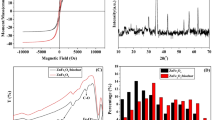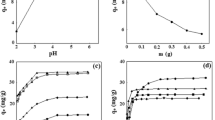Abstract
The aim of this study was to produce magnetic biochar for the removal of As (III) from the aquatic environment. Magnetic biochar (MBC) was prepared from corn straw‑derived biochar. Pristine biochar (BC) was impregnated with iron oxide and relative analyses were performed on the adsorption capacity of BC’s and MBC’s. After impregnation, the specific surface area of MBC800-0.6300 increased from 79.66 to 309.7 m2 g−1 and superparamagnetic magnetization was about 9.75 emu g−1 contributed by the contained Fe3O4. Results of MBC800-0.6300 showed maximum adsorption capacity (Qmax) 22.94 mg g−1 for As (III) based on Langmuir model which is 5.71 times higher than the adsorption capacity of BC800 (4.02 mg g−1). The adsorption of As (III) increased significantly due to the successful loading of iron oxide and the increased oxygen functional groups that were confirmed by XPS and FTIR results. The removal of As (III) followed Langmuir isotherm model and pseudo-second-order (R2 ≥ 0.99), indicated that the adsorption rate was monolayer and depended on the chemical adsorption process, respectively. Consequently, the simple preparation procedure and high adsorption performance suggest that MBC800-0.6300 could be used as an environment-friendly and extremely effective adsorbent for As (III) removal from aqueous environment.





Similar content being viewed by others
References
Asfaram A, Ghaedi M, Ghezelbash GR (2016) Biosorption of Zn 2+, Ni 2+ and co 2+ from water samples onto Yarrowia lipolytica ISF7 using a response surface methodology, and analyzed by inductively coupled plasma optical emission spectrometry (ICP-OES). RSC Adv 6:23599–23610
Baig SA, Zhu J, Muhammad N, Sheng T, Xu X (2014) Effect of synthesis methods on magnetic Kans grass biochar for enhanced as (III, V) adsorption from aqueous solutions. Biomass Bioenergy 71:299–310
Banerjee K, Amy GL, Prevost M, Nour S, Jekel M, Gallagher PM, Blumenschein CD (2008) Kinetic and thermodynamic aspects of adsorption of arsenic onto granular ferric hydroxide (GFH). Water Res 42:3371–3378
Bang S, Johnson MD, Korfiatis GP, Meng X (2005) Chemical reactions between arsenic and zero-valent iron in water. Water Res 39:763–770
Chen T, Quan X, Ji Z, Li X, Pei Y (2020) Synthesis and characterization of a novel magnetic calcium-rich nanocomposite and its remediation behaviour for As (III) and Pb (II) co-contamination in aqueous systems. Sci Total Environ 706:135122
Chowdhury SR, Yanful EK, Pratt AR (2011) Arsenic removal from aqueous solutions by mixed magnetite–maghemite nanoparticles. Environ Earth Sci 64:411–423
Cui J, Jin Q, Li Y, Li F (2019) Oxidation and removal of As (iii) from soil using novel magnetic nanocomposite derived from biomass waste. Environ Sci Nano 6:478–488
Deng J, Liu Y, Liu S, Zeng G, Tan X, Huang B, Tang X, Wang S, Hua Q, Yan Z (2017) Competitive adsorption of Pb (II), Cd (II) and Cu (II) onto chitosan-pyromellitic dianhydride modified biochar. J Colloid Interface Sci 506:355–364
Feng L, Cao M, Ma X, Zhu Y, Hu C (2012) Superparamagnetic high-surface-area Fe3O4 nanoparticles as adsorbents for arsenic removal. J Hazard Mater 217:439–446
Fleker O, Borenstein A, Lavi R, Benisvy L, Ruthstein S, Aurbach D (2016) Preparation and properties of metal organic framework/activated carbon composite materials. Langmuir 32:4935–4944
Fosso-Kankeu E, Mittal H, Waanders F, Ray SS (2017) Thermodynamic properties and adsorption behaviour of hydrogel nanocomposites for cadmium removal from mine effluents. J Ind Eng Chem 48:151–161
Fu D, He Z, Su S, Xu B, Liu Y, Zhao Y (2017) Fabrication of α-FeOOH decorated graphene oxide-carbon nanotubes aerogel and its application in adsorption of arsenic species. J Colloid Interface Sci 505:105–114
Gan Y, Wang Y, Duan Y, Deng Y, Guo X, Ding X (2014) Hydrogeochemistry and arsenic contamination of groundwater in the Jianghan Plain, central China. J Geochemical Explor 138:81–93
Grosvenor AP, Kobe BA, Biesinger MC, McIntyre NS (2004) Investigation of multiplet splitting of Fe 2p XPS spectra and bonding in iron compounds. Surf Interface Anal An Int J Devoted Dev Appl Tech Anal Surfaces Interfaces Thin Film 36:1564–1574
Hao L, Liu M, Wang N, Li G (2018) A critical review on arsenic removal from water using iron-based adsorbents. RSC Adv 8:39545–39560
Hlongwane GN, Sekoai PT, Meyyappan M, Moothi K (2019) Simultaneous removal of pollutants from water using nanoparticles: a shift from single pollutant control to multiple pollutant control. Sci Total Environ 656:808–833
Hu X, Ding Z, Zimmerman AR, Wang S, Gao B (2015) Batch and column sorption of arsenic onto iron-impregnated biochar synthesized through hydrolysis. Water Res 68:206–216
Khan ZH, Gao M, Qiu W, Islam MS, Song Z (2020) Mechanisms for cadmium adsorption by magnetic biochar composites in an aqueous solution. Chemosphere 246:125701. https://doi.org/10.1016/j.chemosphere.2019.125701
Kumar ASK, Jiang S-J (2017) Synthesis of magnetically separable and recyclable magnetic nanoparticles decorated with β-cyclodextrin functionalized graphene oxide an excellent adsorption of As (V)/(III). J Mol Liq 237:387–401
Kyzas GZ, Matis KA (2015) Nanoadsorbents for pollutants removal: a review. J Mol Liq 203:159–168
Li R, Wang JJ, Zhou B, Awasthi MK, Ali A, Zhang Z, Lahori AH, Mahar A (2016) Recovery of phosphate from aqueous solution by magnesium oxide decorated magnetic biochar and its potential as phosphate-based fertilizer substitute. Bioresour Technol 215:209–214
Liu X, Zhang G, Lin L, Khan ZH, Qiu W, Song Z (2018) Synthesis and characterization of novel Fe-Mn-Ce ternary oxide-biochar composites as highly efficient adsorbents for as (III) removal from aqueous solutions. Materials (Basel) 11. https://doi.org/10.3390/ma11122445
Lorenc-Grabowska E, Gryglewicz G (2005) Adsorption of lignite-derived humic acids on coal-based mesoporous activated carbons. J Colloid Interface Sci 284:416–423
Melo LCA, Coscione AR, Abreu CA, Puga AP, Camargo OA (2013) Influence of pyrolysis temperature on cadmium and zinc sorption capacity of sugar cane straw–derived biochar. BioResources 8:4992–5004
Mertens J, Rose J, Kägi R, Chaurand P, Plötze M, Wehrli B, Furrer G (2012) Adsorption of arsenic on polyaluminum granulate. Environ Sci Technol 46:7310–7317
Mohan D, Pittman CU Jr, Bricka M, Smith F, Yancey B, Mohammad J, Steele PH, Alexandre-Franco MF, Gómez-Serrano V, Gong H (2007) Sorption of arsenic, cadmium, and lead by chars produced from fast pyrolysis of wood and bark during bio-oil production. J Colloid Interface Sci 310:57–73
Mohan D, Kumar H, Sarswat A, Alexandre-Franco M, Pittman CU Jr (2014) Cadmium and lead remediation using magnetic oak wood and oak bark fast pyrolysis bio-chars. Chem Eng J 236:513–528
Navarathna CM, Karunanayake AG, Gunatilake SR, Pittman CU Jr, Perez F, Mohan D, Mlsna T (2019) Removal of arsenic (III) from water using magnetite precipitated onto Douglas fir biochar. J Environ Manag 250:109429
Navarathna CM, Dewage NB, Karunanayake AG, Farmer EL, Perez F, Mlsna TE, Pittman CU (2020) Rhodamine B adsorptive removal and photocatalytic degradation on MIL-53-Fe MOF/magnetic magnetite/biochar composites. J Inorg Organomet Polym Mater 30:214–229
Niazi NK, Bibi I, Shahid M, Ok YS, Shaheen SM, Rinklebe J, Wang H, Murtaza B, Islam E, Nawaz MF (2018) Arsenic removal by Japanese oak wood biochar in aqueous solutions and well water: investigating arsenic fate using integrated spectroscopic and microscopic techniques. Sci Total Environ 621:1642–1651
Pan S, Zhang Y, Shen H, Hu M (2012) An intensive study on the magnetic effect of mercapto-functionalized nano-magnetic Fe3O4 polymers and their adsorption mechanism for the removal of Hg (II) from aqueous solution. Chem Eng J 210:564–574
Peiris C, Nayanathara O, Navarathna CM, Jayawardhana Y, Nawalage S, Burk G, Karunanayake AG, Madduri SB, Vithanage M, Kaumal MN (2019) The influence of three acid modifications on the physicochemical characteristics of tea-waste biochar pyrolyzed at different temperatures: a comparative study. RSC Adv 9:17612–17622
Qi Z, Joshi TP, Liu R, Li Y, Liu H, Qu J (2018) Adsorption combined with superconducting high gradient magnetic separation technique used for removal of arsenic and antimony. J Hazard Mater 343:36–48
Reddy DHK, Lee S-M (2013) Three-dimensional porous spinel ferrite as an adsorbent for Pb (II) removal from aqueous solutions. Ind Eng Chem Res 52:15789–15800
Reddy KR, Hassan M, Gomes VG (2015) Hybrid nanostructures based on titanium dioxide for enhanced photocatalysis. Appl Catal A Gen 489:1–16
Samsuri AW, Sadegh-Zadeh F, Seh-Bardan BJ (2013) Adsorption of As (III) and As (V) by Fe coated biochars and biochars produced from empty fruit bunch and rice husk. J Environ Chem Eng 1:981–988
Shehzad K, Xie C, He J, Cai X, Xu W, Liu J (2018) Facile synthesis of novel calcined magnetic orange peel composites for efficient removal of arsenite through simultaneous oxidation and adsorption. J Colloid Interface Sci 511:155–164
Song Z, Lian F, Yu Z, Zhu L, Xing B, Qiu W (2014) Synthesis and characterization of a novel MnOx-loaded biochar and its adsorption properties for Cu2+ in aqueous solution. Chem Eng J 242:36–42
Van Vinh N, Zafar M, Behera SK, Park H-S (2015) Arsenic (III) removal from aqueous solution by raw and zinc-loaded pine cone biochar: equilibrium, kinetics, and thermodynamics studies. Int J Environ Sci Technol 12:1283–1294
Vithanage M, Herath I, Joseph S, Bundschuh J, Bolan N, Ok YS, Kirkham MB, Rinklebe J (2017) Interaction of arsenic with biochar in soil and water: a critical review. Carbon N Y 113:219–230
Wang Y, Sun H, Ang HM, Tadé MO, Wang S (2014) Magnetic Fe3O4/carbon sphere/cobalt composites for catalytic oxidation of phenol solutions with sulfate radicals. Chem Eng J 245:1–9
Wang S, Gao B, Zimmerman AR, Li Y, Ma L, Harris WG, Migliaccio KW (2015) Removal of arsenic by magnetic biochar prepared from pinewood and natural hematite. Bioresour Technol 175:391–395
Wathudura PD, Peiris C, Navarathna CM, Mlsna TE, Kaumal MN, Vithanage M, Gunatilake SR (2020) Microwave and open vessel digestion methods for biochar. Chemosphere 239:124788
Whitehouse BG (1984) The effects of temperature and salinity on the aqueous solubility of polynuclear aromatic hydrocarbons. Mar Chem 14:319–332
WHO (2011) Guidelines for drinking-water quality. WHO Chron 38:104–108
Wu J, Yi Y, Li Y, Fang Z, Tsang EP (2016) Excellently reactive Ni/Fe bimetallic catalyst supported by biochar for the remediation of decabromodiphenyl contaminated soil: reactivity, mechanism, pathways and reducing secondary risks. J Hazard Mater 320:341–349
Wu H, Feng Q, Yang H, Alam E, Gao B, Gu D (2017) Modified biochar supported Ag/Fe nanoparticles used for removal of cephalexin in solution: characterization, kinetics and mechanisms. Colloids Surfaces A Physicochem Eng Asp 517:63–71
Wu J, Huang D, Liu X, Meng J, Tang C, Xu J (2018) Remediation of As (III) and Cd (II) co-contamination and its mechanism in aqueous systems by a novel calcium-based magnetic biochar. J Hazard Mater 348:10–19
Zhang M, Gao B, Varnoosfaderani S, Hebard A, Yao Y, Inyang M (2013) Preparation and characterization of a novel magnetic biochar for arsenic removal. Bioresour Technol 130:457–462
Zhang L, Qin X, Tang J, Liu W, Yang H (2017) Review of arsenic geochemical characteristics and its significance on arsenic pollution studies in karst groundwater. Southwest China Appl Geochem 77:80–88
Zhou Y-F, Haynes RJ (2011) Removal of Pb (II), Cr (III) and Cr (VI) from aqueous solutions using alum-derived water treatment sludge. Water Air Soil Pollut 215:631–643
Zhou J, He J, Li G, Wang T, Sun D, Ding X, Zhao J, Wu S (2010) Direct incorporation of magnetic constituents within ordered mesoporous carbon− silica nanocomposites for highly efficient electromagnetic wave absorbers. J Phys Chem C 114:7611–7617
Zhou Z, Liu Y, Liu S, Liu H, Zeng G, Tan X, Yang C, Ding Y, Yan Z, Cai X (2017) Sorption performance and mechanisms of arsenic (V) removal by magnetic gelatin-modified biochar. Chem Eng J 314:223–231
Funding
This study was funded by the National Natural Science Foundation of China (nos. 41771525), STU Scientific Research Foundation for Talents (NTF19025).
Author information
Authors and Affiliations
Corresponding author
Ethics declarations
Conflict of interest
The authors declare that they have no conflict of interest.
Additional information
Responsible editor: Zhihong Xu
Publisher’s note
Springer Nature remains neutral with regard to jurisdictional claims in published maps and institutional affiliations.
Electronic supplementary material
ESM 1
(DOCX 9984 kb)
Rights and permissions
About this article
Cite this article
Khan, Z.H., Gao, M., Qiu, W. et al. The sorbed mechanisms of engineering magnetic biochar composites on arsenic in aqueous solution. Environ Sci Pollut Res 27, 41361–41371 (2020). https://doi.org/10.1007/s11356-020-10082-x
Received:
Accepted:
Published:
Issue Date:
DOI: https://doi.org/10.1007/s11356-020-10082-x




